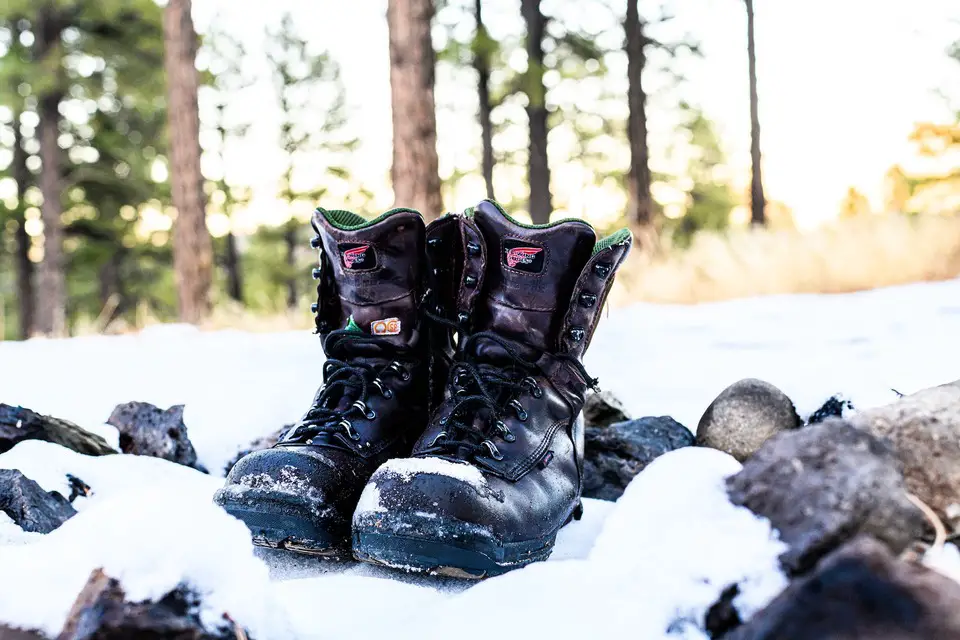Are Hiking Boots Good For Snow?

When you’re out on your hike, your shoes are your foundation. They are one of the most important items to consider when planning your next outdoor adventure. If you’re considering taking a hike out in the snow, you may have a few questions as to whether you can use a regular hiking boot or if you should sink some more money to invest in a boot specially made for colder weather conditions. So in this article, we’ll explore whether a regular hiking boot is good for snow and some things to consider if you do choose to use one.
Quick Links
Can You Wear Regular Hiking Boots in Winter Weather?
Most proper hiking boots are made with the idea that you are going to be crossing over many different types of terrains with all types of textures. Because of this, most hiking boots come with specially designed soles that help keep your feet sturdy as you make your way across dirt, mud, and slippery rocks.
Although a standard hiking boot is made for a myriad of terrains, if you’re planning for your next hike to be in an area where there will be more than a few patches of snow or ice, you should consider getting boots that are specifically for the colder temperatures. You may be wondering why you should get boots specifically for the snow if you already have an excellent pair into which you’ve already sunk a good chunk of change.
Are Hiking Boots Safe to Wear on Ice?
Most hiking boots come equipped with soles to stand against different types of terrain; however, not every hiking boot is going to stand a chance against slippery ice. If you do choose to take your standard hiking boot out where you anticipate there will be patches of ice, you should consider buying boot accessories such as microspikes or crampons that will offer you an extra level of traction to keep yourself safe.
Traction accessories may have a tendency to be a bit bulky and sometimes unnecessary. So to save weight and space, play it safe, and opt for a pair of high-quality snow boots.
If you still need a bit more convincing on why you may want to opt for a pair of snow boots instead of your standard hiking boots for your snowy hiking adventures, here are a few key differences and similarities between the two boots:
Differences Between Hiking Boots And Snow Boots
Insulation
A key difference between a standard hiking boot and a snow hiking boot is the level of insulation that each boot offers. A standard hiking boot does have the option to come with some form of insulation. However, the amount of insulation offered may pale compared to what a boot specifically made for colder weather offers.
One con of getting a snow hiking boot is that you’re pretty much stuck wearing them in the snow. Otherwise, you risk the potential of overheating your feet and potentially getting a fungal infection due to the excess sweat. You can use your standard hiking boot all year round, depending on the insulation level it offers.
Traction
Typically a standard hiking boot’s level of traction is always gonna be top-notch, depending on the style. However, when it comes to trekking through snow and ice, you may want to consider the extra level of traction a snow boot has to offer.
A snow boot will make sure that any contact with snow or ice will keep your foot as sturdy as possible. A standard hiking boot’s traction has the potential to protect you from any slips or falls on ice, but you should always do your own research into the style of the boot before taking them out in the snow.
Weight
One advantage that a standard hiking boot is going to have over a snow boot is weight. On average, a standard hiking boot is going to be a bit lighter than a snow boot. This weight difference is because a snow boot is going to come with extra insulation such as fur or a thicker insole.
A standard hiking boot likely isn’t going to have all this extra padding; save a few styles that may come with insulation. The heavier the shoe, the more energy you’re going to spend on your hike. So if energy conservation is of concern to you, consider getting a standard hiking boot that comes with insulation that may be somewhat similar to that of a snow boot.
Comfort
In terms of comfortability, both a standard hiking boot and a snow boot have the ability to offer excellent levels of comfort. The only thing that differentiates these two styles of hiking boots is that snow boots are often a lot clunkier than a standard hiking boot. This can potentially hinder comfort when out hiking; however, what snow boots may lack in comfort, they definitely make up for in insulation.
Some snow boots are lined with fur, which can really make them comfortable to walk in. However, it may cause your feet to overheat a bit, leading to discomfort. A standard hiking boot will be more lightweight and breathable, making them very comfortable. If the boot does not come with insulation, taking them out in colder weather may bring some discomfort.
Waterproof
Unfortunately, not all standard hiking boots are waterproof, which can really put a damper on your hike if you choose to take them out in the snow. Remember that snow is just very cold water; when it melts, it creates slush, which can create puddles.
If you decide to take your standard hiking boots out in the snow, which are not made from a waterproof material, this can be a dangerous situation that can potentially bring on hypothermia.
Snow boots will always be waterproof, just based on the activity it’s specially made for. There are waterproof hiking boots; however, these boots may not come with the insulation that a snow boot can offer.
Ankle support
Getting any kind of hiking shoe is likely to provide you with adequate ankle support; however, not all boots are made alike. Depending on the style, a standard hiking boot may not offer as much ankle support as a snow boot. Most snow boots will come higher up on the calf than a standard hiking boot, which naturally offers much more ankle support.
The function of this particular feature of a snow boot is to help keep any and all snow out of your shoe. A standard hiking boot may have the ability to do this, but f you’re hiking in deeper snow, you’ll likely need the help of a pair of gaiters to keep the snow from getting into your boot. Getting a snow boot will be your best bet to prevent this altogether.
Breathability
A standard hiking boot is also going to have a major advantage over a snow boot in terms of breathability. A snow boot is specially made for colder weather, which means that it’s designed to keep in as much warmth as possible. This isn’t great for any kind of breathability, but it really doesn’t matter for a snow boot because this shoe isn’t in competition for standard hiking boots that may be worn in warmer temperatures.
Standard hiking boots are great for regulating internal temperatures, and while this may be great for hiking in warm weather or autumn season weather, they may not be the best choice for harsher winter temperatures.
Conclusion
In conclusion, while you may save money and some weight if you decide to take your standard hiking boot out with you in the snow, you’re ultimately going to get the most warmth and traction opting for a good quality snow boot. When it comes to your hike, your foundation is everything. Your feet are the tool that takes you through your journey, so be discerning when choosing the type of shoe you want to out with you, especially if you’re anticipating more frigid weather conditions.






